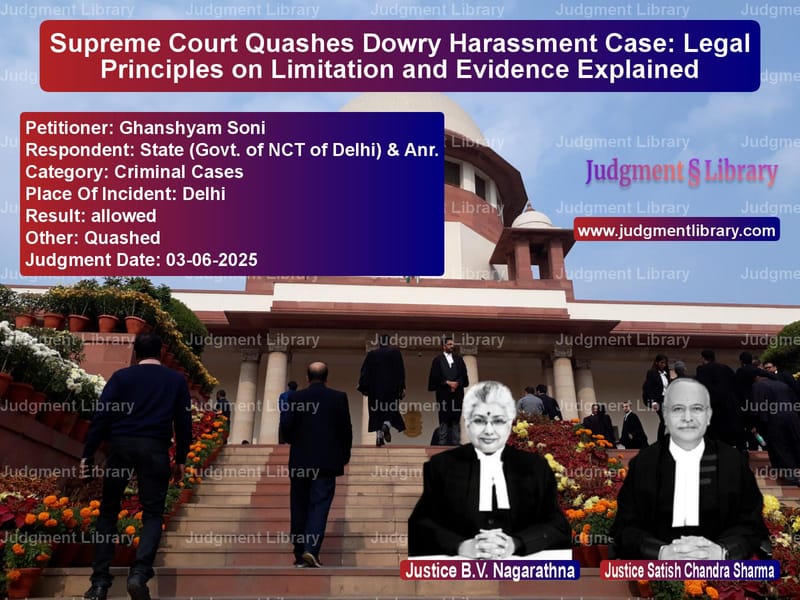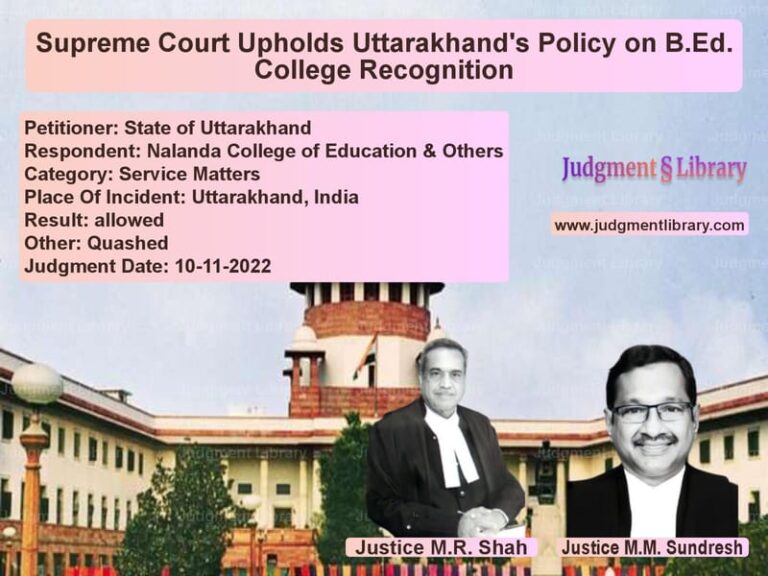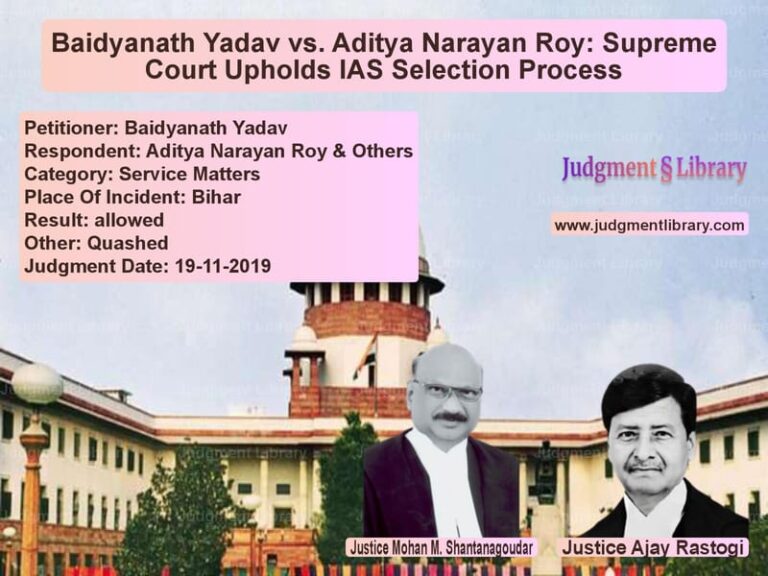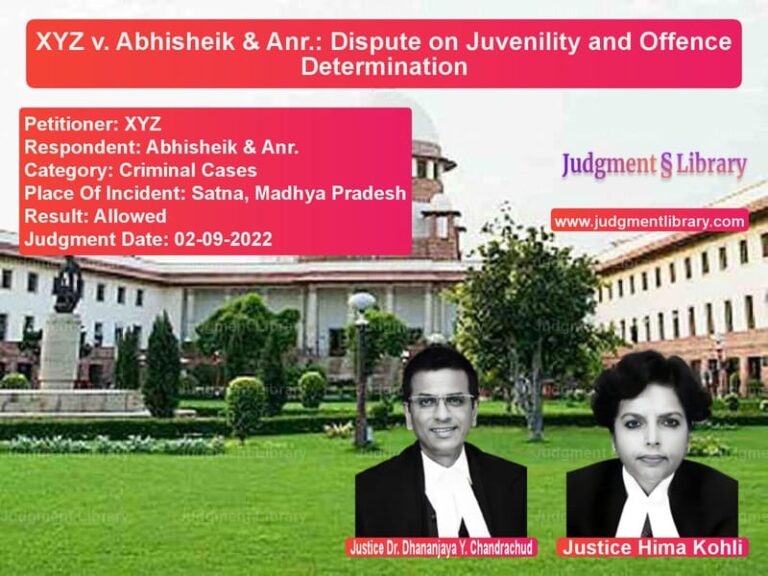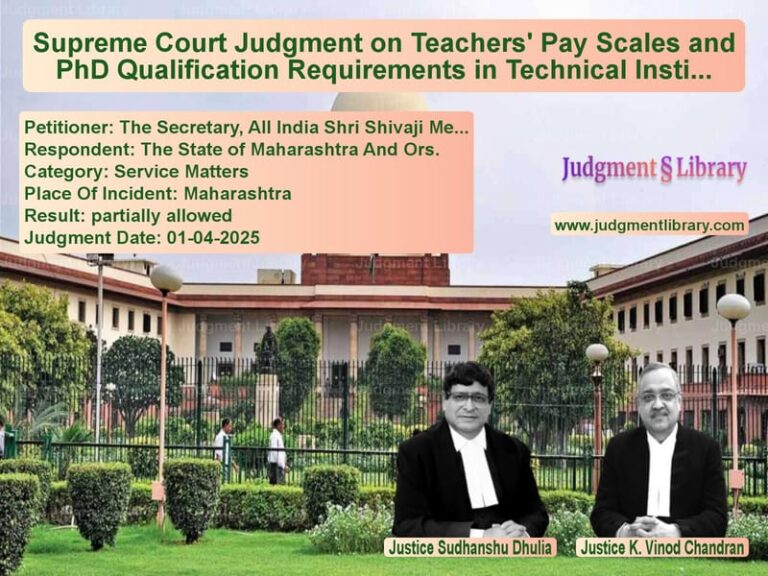Supreme Court Quashes Dowry Harassment Case: Legal Principles on Limitation and Evidence Explained
In a significant judgment addressing the misuse of dowry laws and the importance of timely legal action, the Supreme Court of India has quashed criminal proceedings against a police officer husband and his family members in a case dating back more than two decades. The judgment, delivered by a bench comprising Justice B.V. Nagarathna and Justice Satish Chandra Sharma, provides crucial guidance on the interpretation of limitation periods in criminal cases and the standards required for framing charges in matrimonial disputes.
The Background of the Case
The legal battle began with the marriage between Ghanshyam Soni and the complainant wife on February 28, 1998, according to Buddhist rites and ceremonies. Both parties were serving as Sub-Inspectors with the Delhi Police at the time. The complainant alleged that soon after marriage, she learned about the greedy and abusive nature of her husband and his family members, who constantly taunted and ridiculed her for bringing insufficient dowry.
The prosecution case alleged that the appellant and his family consistently raised demands for more dowry, specifically demanding Rs. 1.5 lakhs in cash, a car, and a separate house. The complainant claimed that despite serious effort, her father was unable to meet these demands, leading to physical and mental atrocities. Specific incidents cited included an alleged beating on April 27, 1999, where the complainant claimed to have hurt her wrist, and a threat with a dagger on September 4, 1999. The complainant was allegedly thrown out of the matrimonial house on September 8, 1999, and not allowed to take her belongings.
Read also: https://judgmentlibrary.com/supreme-court-overturns-murder-conviction-in-medical-student-death-case/
The Legal Journey Through Courts
The criminal machinery was set in motion with a complaint dated July 3, 2002, filed by the complainant wife, culminating in FIR No. 1098/2002 dated December 19, 2002, registered at PS Malviya Nagar against the appellant husband and his in-laws for offenses under Sections 498A, 406 & 34 IPC. The chargesheet was filed on July 27, 2004, and the Metropolitan Magistrate took cognizance on the same day.
The appellant filed a Criminal Revision Petition before the Sessions Court, which discharged the appellant, his mother, and five sisters for offenses under Section 498A & 34 IPC. The Sessions Court observed that the Magistrate had taken cognizance of a time-barred case since cognizance was taken on July 27, 2004, for alleged incidents of cruelty pertaining to 1999 – five years after the commission of the alleged offense, whereas the limitation period for an offense punishable under Section 498A is three years.
The Sessions Court made controversial observations about the complainant’s status as a police officer: “In the present case unlike the Ramesh’s case (supra) relied upon by the learned trial court in the impugned order the complainant is a police officer and is supposed to be a tough person used to deal with hard situations, by virtue of her job which includes her handling the criminals besides tough and hard job of police officer. Such a strong-and tough person is not only almost immune to be pressurized but also can be harsh and strong in reaction to other persons going against her-wishes.”
The complainant then approached the High Court under Section 482 CrPC, which set aside the Sessions Court’s order, observing that the findings were perverse. The appellant then approached the Supreme Court.
Arguments Before the Supreme Court
The appellant’s counsel argued vehemently that the case was time-barred and the Magistrate could not have taken cognizance in light of the bar under Section 468 CrPC. They contended that all three complaints mentioned the same incidents of cruelty from 1999, and there was no explanation for the inordinate delay in filing the FIR dated December 19, 2002, more than three years after the alleged incidents.
The counsel argued that “the allegations in the FIR are false, and no prima facie case can be made out against the Appellant or his family, even after the perusal of the material on record.”
On the other hand, the complainant’s counsel argued that “it cannot be assumed at this stage when the trial is yet to commence that the Complaints filed by her are false, simply because she is a police officer.” They contended that since there were specific allegations of physical and mental harassment, the Sessions Court could not have discharged the appellant without him standing the test of trial.
The complainant’s counsel further argued that “the last alleged offence was committed on 06.12.1999, and complaints were filed both on 06.12.1999 and 03.07.2002 which is well-within the three year limitation period in terms of section 468 CrPC.” They maintained that an offense under Section 498A is a continuing offense, and there were serious allegations made even after September or December 1999.
The Supreme Court’s Analysis
The Supreme Court began its analysis by examining the allegations in the FIR, noting that they were “generic, and rather ambiguous.” The Court observed that the allegations against family members were that they used to instigate the appellant to harass the complainant, but there was no specific incident of harassment or any evidence to that effect.
The Court made a crucial observation about roping in distant relatives: “The Courts should be careful in proceeding against the distant relatives in crimes pertaining to matrimonial disputes and dowry deaths. The relatives of the husband should not be roped in on the basis of omnibus allegations unless specific instances of their involvement in the crime are made out.”
Regarding the allegations against the appellant, the Court found them “obscure in nature” and noted that “apart from the bald allegations without any specifics of time, date or place, there is no incriminating material found by the prosecution or rather produced by the complainant to substantiate the ingredients of ‘cruelty’ under section 498A IPC.”
The Court particularly noted that the complainant had failed to produce any medical records, injury reports, x-ray reports, or any witnesses to substantiate her allegations. Additionally, the complainant had withdrawn her second complaint dated December 6, 1999, just six days later on December 12, 1999.
Limitation Period Interpretation
The Supreme Court provided crucial clarification on the computation of limitation periods under Section 468 CrPC. The Court held: “It is a settled position of law that for the computation of the limitation period under Section 468 CrPC the relevant date is the date of filing of the complaint or the date of institution of prosecution and not the date on which the Magistrate takes cognizance.”
The Court referred to its earlier decision in Bharat Damodar Kale & Anr. v. State of Andhra Pradesh, where it was held: “for the purpose of computing the period of limitation, the relevant date must be considered as the date of filing of complaint or initiating criminal proceedings and not the date of taking cognizance by a Magistrate or issuance of process by a court.”
The Court further elaborated: “The Code imposes an obligation on the aggrieved party to take recourse to appropriate forum within the period provided by law and once he takes such action, it would be wholly unreasonable and inequitable if he is told that his grievance would not be ventilated as the court had not taken an action within the period of limitation. Such interpretation of law, instead of promoting justice would lead to perpetuate injustice and defeat the primary object of procedural law.”
Applying this principle, the Court found that the complaint dated July 3, 2002, was filed within three years from the last alleged incident on December 6, 1999, and was therefore within the limitation period.
Misuse of Legal Provisions
The Supreme Court expressed concern about the growing tendency to misuse legal provisions in matrimonial disputes. The Court noted: “It is rather unfortunate that the Complainant being an officer of the State has initiated criminal machinery in such a manner, where the aged parents-in-law, five sisters and one tailor have been arrayed as an accused.”
The Court emphasized that while it agreed with the High Court’s sensitive approach that a police officer could also be a victim of cruelty, “a judicial decision cannot be blurred to the actual facts and circumstances of a case.”
The Court found that scrutiny of the allegations and material on record revealed that no prima facie case was made out against the appellant or his family. The Court also noted that the divorce decree of their marriage had already been passed and had never been challenged by the complainant wife, thus attaining finality.
Conclusion and Legal Impact
In its final analysis, the Supreme Court held: “Upon consideration of the relevant circumstances and that the alleged incidents pertain to the year 1999 and since then the parties have moved on with their respective lives, it would be unjust and unfair if the Appellants are forced to go through the tribulations of a trial.”
The Court, in exercise of its powers under Article 142 of the Constitution of India, quashed and set aside FIR No. 1098/2002 and the chargesheet dated July 27, 2004.
This judgment serves as an important precedent in several aspects of criminal law. It reinforces the principle that limitation periods must be computed from the date of filing the complaint, not from the date of cognizance. It emphasizes the need for specific allegations and evidence in dowry harassment cases, particularly when distant relatives are implicated. The decision also highlights the judiciary’s concern about the misuse of legal provisions in matrimonial disputes while maintaining that the professional status of a complainant cannot be the sole basis for dismissing their allegations. The judgment balances the rights of genuine victims with the protection of innocent persons from false implications, ensuring that legal processes are not misused to settle personal scores.
Petitioner Name: Ghanshyam Soni.Respondent Name: State (Govt. of NCT of Delhi) & Anr..Judgment By: Justice B.V. Nagarathna, Justice Satish Chandra Sharma.Place Of Incident: Delhi.Judgment Date: 03-06-2025.Result: allowed.
Don’t miss out on the full details! Download the complete judgment in PDF format below and gain valuable insights instantly!
Download Judgment: ghanshyam-soni-vs-state-(govt.-of-nct-supreme-court-of-india-judgment-dated-03-06-2025.pdf
Directly Download Judgment: Directly download this Judgment
See all petitions in Dowry Cases
See all petitions in Judgment by B.V. Nagarathna
See all petitions in Judgment by Satish Chandra Sharma
See all petitions in allowed
See all petitions in Quashed
See all petitions in supreme court of India judgments June 2025
See all petitions in 2025 judgments
See all posts in Criminal Cases Category
See all allowed petitions in Criminal Cases Category
See all Dismissed petitions in Criminal Cases Category
See all partially allowed petitions in Criminal Cases Category

